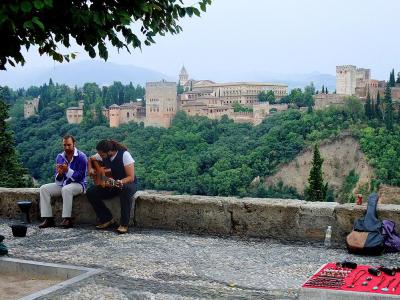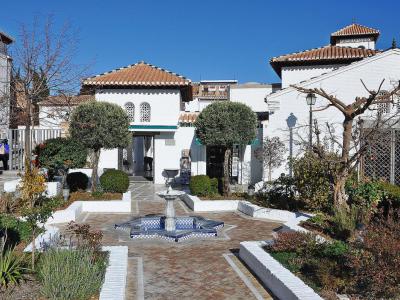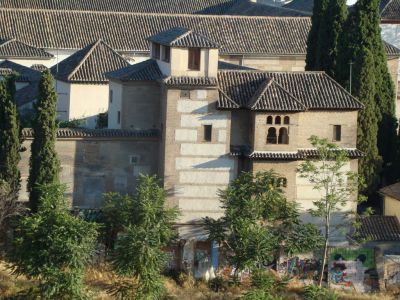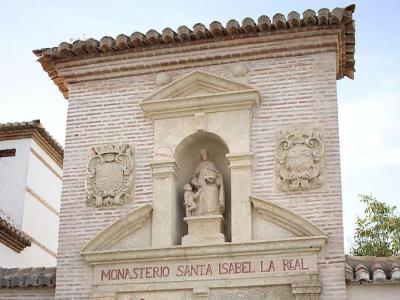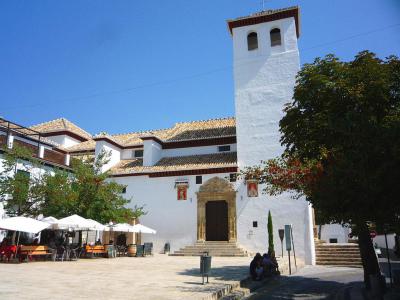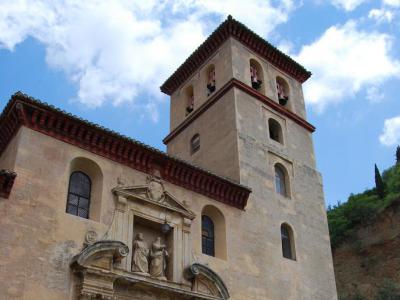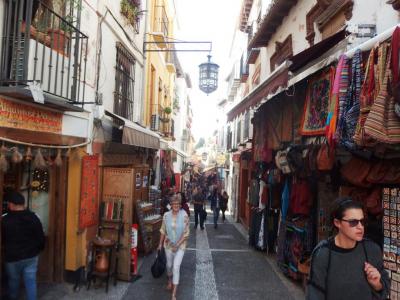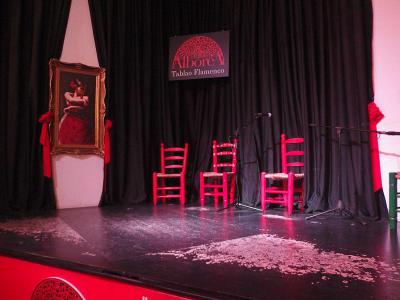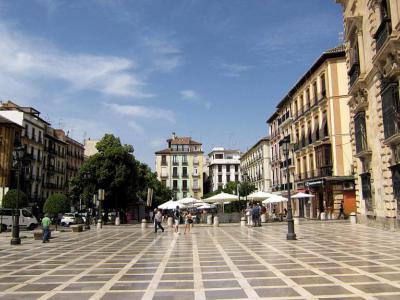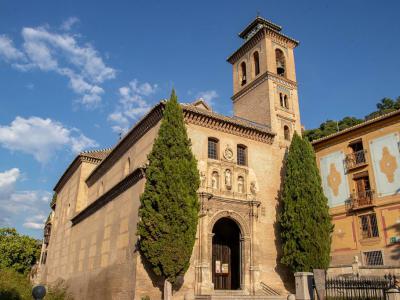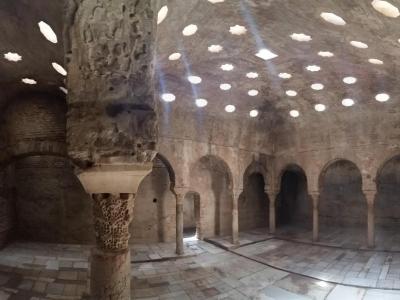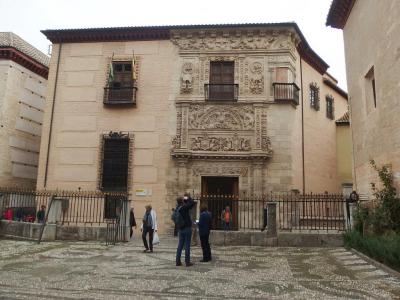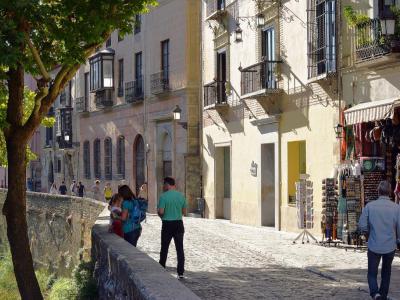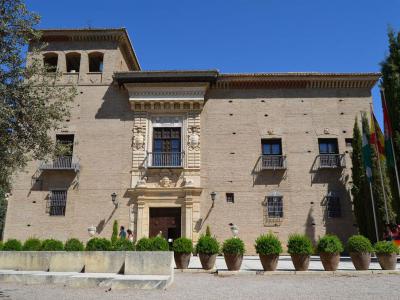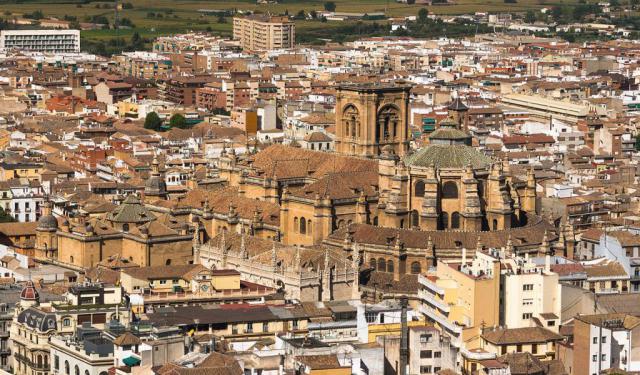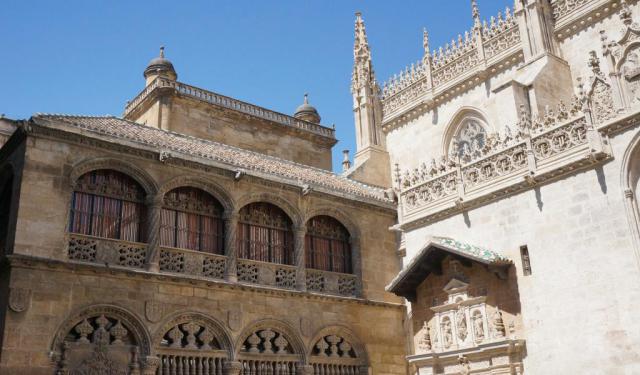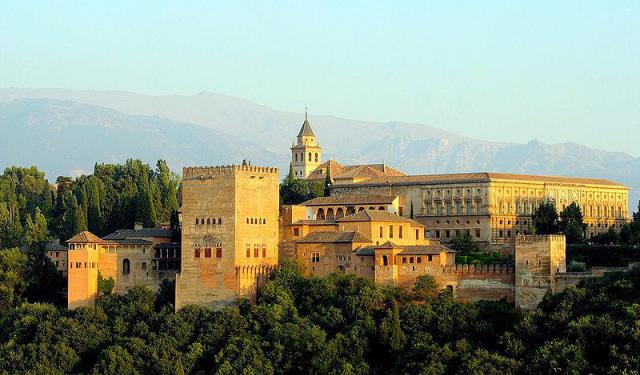Albayzín Walking Tour (Self Guided), Granada
The Moorish quarter of Albaycín is a world of its own inside Granada. Mainly, this is due to a strong Islamic vibe still present in the area. The city's oldest district was established by Arabs in the 11th century and to date has retained much of its original charm, manifested in the neat maze of narrow Medieval lanes, shady, intimate courtyards and squares, plus a multitude of well-kept, traditional whitewashed houses built practically on top of one another. As an open-air museum of history and architecture, Albaycín was declared a UNESCO World Heritage site in 1994.
The neighborhood is particularly popular for the spectacular San Nicolas Lookout, affording dramatic views, especially at sunset, of the magnificent Alhambra fortress and its terraced gardens, perched on top of a hillock, with the charming Sierra Nevada mountain range at the backdrop, glowing in the rays of the sinking sun.
Some say, the name Albaycín means "quarter of the falconers", although most historians incline towards "quarter of the people of Baeza", referring to the Moors settled here after Christians drove them out of their hometown of Baeza in the 13th century.
Nowadays, the only Moorish palace here still in place is the 15th century Dar al-Horra. Another Moorish remnant is the 11th-century El Bañuelo, a traditional Arab bath found at Carrera del Darro. Built above the house, it escaped demolition unlike most Arab baths in the district – viewed by Christians as brothels and therefore destroyed.
Following the reconquest of Granada by the Catholic Kings in 1492, many local mosques were torn down and replaced with churches. One such is the San José church, with a minaret turned into belfry.
If you wish to delve deeper into Andalusia's Medieval Moorish past, take this self-guided walk in Albaycín as an educational part of your Granada city trip.
The neighborhood is particularly popular for the spectacular San Nicolas Lookout, affording dramatic views, especially at sunset, of the magnificent Alhambra fortress and its terraced gardens, perched on top of a hillock, with the charming Sierra Nevada mountain range at the backdrop, glowing in the rays of the sinking sun.
Some say, the name Albaycín means "quarter of the falconers", although most historians incline towards "quarter of the people of Baeza", referring to the Moors settled here after Christians drove them out of their hometown of Baeza in the 13th century.
Nowadays, the only Moorish palace here still in place is the 15th century Dar al-Horra. Another Moorish remnant is the 11th-century El Bañuelo, a traditional Arab bath found at Carrera del Darro. Built above the house, it escaped demolition unlike most Arab baths in the district – viewed by Christians as brothels and therefore destroyed.
Following the reconquest of Granada by the Catholic Kings in 1492, many local mosques were torn down and replaced with churches. One such is the San José church, with a minaret turned into belfry.
If you wish to delve deeper into Andalusia's Medieval Moorish past, take this self-guided walk in Albaycín as an educational part of your Granada city trip.
How it works: Download the app "GPSmyCity: Walks in 1K+ Cities" from Apple App Store or Google Play Store to your mobile phone or tablet. The app turns your mobile device into a personal tour guide and its built-in GPS navigation functions guide you from one tour stop to next. The app works offline, so no data plan is needed when traveling abroad.
Albayzín Walking Tour Map
Guide Name: Albayzín Walking Tour
Guide Location: Spain » Granada (See other walking tours in Granada)
Guide Type: Self-guided Walking Tour (Sightseeing)
# of Attractions: 15
Tour Duration: 2 Hour(s)
Travel Distance: 2.3 Km or 1.4 Miles
Author: anna
Sight(s) Featured in This Guide:
Guide Location: Spain » Granada (See other walking tours in Granada)
Guide Type: Self-guided Walking Tour (Sightseeing)
# of Attractions: 15
Tour Duration: 2 Hour(s)
Travel Distance: 2.3 Km or 1.4 Miles
Author: anna
Sight(s) Featured in This Guide:
- Mirador de San Nicolas (San Nicolas Lookout)
- Mezquita del Albaicín (Albaicín Mosque)
- Palacio de Dar-al-Horra (Dar-al-Horra Palace)
- Monastery of Santa Isabel la Real
- Low San Miguel Square and Church
- San Jose Church
- Calle Calderería Nueva (New Caldereria Street)
- Tablao Flamenco La Alborea
- Plaza Nueva (The New Square)
- Church of San Gil and Santa Ana
- El Bañuelo (Traditional Arab Bath)
- Archaeological Museum of Granada (Castril Palace)
- Carrera del Darro (Darro Street)
- Paseo de los Tristes (The Promenade of the Sad)
- Palacio de los Cordova
1) Mirador de San Nicolas (San Nicolas Lookout) (must see)
Bill Clinton is supposed to have said "the most beautiful sunset in the world" when speaking of the sunset view from San Nicolas Lookout. San Nicolas does offer the best view of the Alhambra at sunset, but there are a lot of spectacular lookouts in Granada. San Cristobal is reputed to be a fantastic viewpoint of the City.
Each clear day at sunset there is a crowd gathering in the square of San Nicolas. They are there to watch the Alhambra turn red in the setting sun. Alhambra in Arabic means "red castle." Tourists, locals, and travelers come together at the overlook. There are vendors hawking snacks, flamenco dancers, souvenir sellers and other entertainments.
The lookout is named for San Nicolas Church and Square. The church was built on the top of a mosque in 1525. There seems to have been a trend, when the Catholic Monarchs took over in 1491, to drop a church on a mosque. Location, location, the man said. The church has been destroyed several times by fires, but the original bell tower survives.
For only a few euros it is possible to climb the tower San Nicolas and get a better view.
Each clear day at sunset there is a crowd gathering in the square of San Nicolas. They are there to watch the Alhambra turn red in the setting sun. Alhambra in Arabic means "red castle." Tourists, locals, and travelers come together at the overlook. There are vendors hawking snacks, flamenco dancers, souvenir sellers and other entertainments.
The lookout is named for San Nicolas Church and Square. The church was built on the top of a mosque in 1525. There seems to have been a trend, when the Catholic Monarchs took over in 1491, to drop a church on a mosque. Location, location, the man said. The church has been destroyed several times by fires, but the original bell tower survives.
For only a few euros it is possible to climb the tower San Nicolas and get a better view.
2) Mezquita del Albaicín (Albaicín Mosque)
The Mezquita del Albaycín (Albaycín Mosque), also known as The Great Mosque of Granada, was opened in 2003, and is the first mosque built in the city since the Christian Reconquista in 1492.
The Mosque features traditional Arabic style with architectural accents of the Nasrid Empire. Located in Plaza San Nicolás, in the historic Albaycín neighborhood, The Great Mosque is made up of three sections: the garden, the prayer room (which is the mosque itself) and the Center for Islamic Studies.
The prayer section is decorated with sober elements borrowed from Islamic artistic traditions. The mihrab, which marks the direction of prayer towards Mecca, is a replica of the one in the Mosque of Córdoba. The cedar wood panels of the Atlas, carved by hand, contain an ayah from the Qur'an, where some of the divine attributes are named.
The marble panels of different colors are identical to those of the Al Aqsa Mosque in Jerusalem. The large windows of the qibla are copies of those of the Blue Mosque in Istanbul. The fountain and the mosaics in the courtyard, that gives access to the prayer room, have been made by artisans from Fez, Morocco, who have recreated the designs and used same techniques as in Muslim Granada 1000 years ago.
The minaret is a tower of genuinely Albaicine proportions and silhouette. The mosaic inscription with Kufic calligraphy, which can be read under its eaves, is the declaration of faith of the Muslims: “There is no god but Allah. Muhammad is the messenger of Allah." On the ground floor, in the main entrance hall there is a reception desk and a store selling books, crafts and souvenirs.
The Mosque features traditional Arabic style with architectural accents of the Nasrid Empire. Located in Plaza San Nicolás, in the historic Albaycín neighborhood, The Great Mosque is made up of three sections: the garden, the prayer room (which is the mosque itself) and the Center for Islamic Studies.
The prayer section is decorated with sober elements borrowed from Islamic artistic traditions. The mihrab, which marks the direction of prayer towards Mecca, is a replica of the one in the Mosque of Córdoba. The cedar wood panels of the Atlas, carved by hand, contain an ayah from the Qur'an, where some of the divine attributes are named.
The marble panels of different colors are identical to those of the Al Aqsa Mosque in Jerusalem. The large windows of the qibla are copies of those of the Blue Mosque in Istanbul. The fountain and the mosaics in the courtyard, that gives access to the prayer room, have been made by artisans from Fez, Morocco, who have recreated the designs and used same techniques as in Muslim Granada 1000 years ago.
The minaret is a tower of genuinely Albaicine proportions and silhouette. The mosaic inscription with Kufic calligraphy, which can be read under its eaves, is the declaration of faith of the Muslims: “There is no god but Allah. Muhammad is the messenger of Allah." On the ground floor, in the main entrance hall there is a reception desk and a store selling books, crafts and souvenirs.
3) Palacio de Dar-al-Horra (Dar-al-Horra Palace)
The Palacio de Dar-al-Horra was built by the Emirs of Granada in the 15th century, shortly before their rule was ended by Christian conquistadors. The palace was built upon the remains of a destroyed palace, and is the only Muslim palace in the Albayzin to have been at least partially preserved. The name ‘Dar-al-Horra’ translates from Arabic as ‘the House of the Honest Lady’. This is believed to refer to the mother of King Boabdil, the last Arab monarch of Spain, who lived in the palace until 1492, when Granada was claimed by the Catholic monarchs.
Following the Conquest of Granada, the palace was converted by Queen Isabella into the Santa Isabel la Real convent. Whilst the convent still exists within the palace compound, those parts of the original palace that remain are owned by the government, and listed as a national monument. The palace is filled with examples of Nasrid art, which combines Arabic and European artistic styles. The central courtyard is flanked by two porticoes, with a small pool and fountain in the southern portico. The northern portico is notable for its horseshoe shaped arches and ornate Medujar style ceiling, made from wood carved in a geometric pattern.
Following the Conquest of Granada, the palace was converted by Queen Isabella into the Santa Isabel la Real convent. Whilst the convent still exists within the palace compound, those parts of the original palace that remain are owned by the government, and listed as a national monument. The palace is filled with examples of Nasrid art, which combines Arabic and European artistic styles. The central courtyard is flanked by two porticoes, with a small pool and fountain in the southern portico. The northern portico is notable for its horseshoe shaped arches and ornate Medujar style ceiling, made from wood carved in a geometric pattern.
4) Monastery of Santa Isabel la Real
The Monastery of Santa Isabel la Real stands on the Camino Nuevo de San Nicolás, next to San Miguel Bajo church. It was built on the site of Dar al-Horra, a former Moorish palace. It was founded by Queen Isabella of Castile following the conquest of Granada. The monastery was designed in the Gothic style, known locally as ‘Isabella’s style’ due to its popularity with the Queen. It was completed in the 16th century, and bears her coat of arms on the entrance door.
The church’s interior is notable for several unusual items. These include a Mudejar ceiling above the nave, comprised of fretted woodwork in a style associated with Moorish craftsmen. The church also houses the tomb of sculptor Bernardo Francisco de Mora. The font is formed from the remnants of a fountain recovered from the remains of the palace. The statue of the Virgin Mary, along with several wooden crosses seen on the walls of the monastery, is carried by the resident nuns through Granada’s streets for the Easter parade. The nuns that live at the monastery can be heard singing next to the nave each evening at 7pm. They also sell pastries, which can be bought through a revolving window within the church.
The church’s interior is notable for several unusual items. These include a Mudejar ceiling above the nave, comprised of fretted woodwork in a style associated with Moorish craftsmen. The church also houses the tomb of sculptor Bernardo Francisco de Mora. The font is formed from the remnants of a fountain recovered from the remains of the palace. The statue of the Virgin Mary, along with several wooden crosses seen on the walls of the monastery, is carried by the resident nuns through Granada’s streets for the Easter parade. The nuns that live at the monastery can be heard singing next to the nave each evening at 7pm. They also sell pastries, which can be bought through a revolving window within the church.
5) Low San Miguel Square and Church
Low San Miguel is low because it is lower than the other San Miguel, High San Miguel. Low San Miguel church has a humble simple appearance, but the church and the plaza tell the story of the city.
The fountain alongside the church is of red brick, indicating the church may have been a mosque in the time of the Muslim Almohads. Two marble columns from the Roman imperial age suggest an even earlier time. A statue of Christ on the cross is bound with iron clamps, a veteran of the Spanish civil war.
The church was built in the Mudejar style but it has Renaissance accents. The entrance is flanked by two corinthian columns and pilasters bearing shields. There is an image of San Miguel above the doors, made in 1558 by Toribio de Liébana. On the sides of San Miguel's niche are two oculi with angels. On the western portal is Saint Peter, similarly arranged.
The church has one nave and side chapels, a Main Chapel and a choir. In the 16th century Tomas de Morales installed an altarpiece in two sections. In 1753 Blas Moreno replaced Morales' altar pieces with an altar with sculptures by Turcato Ruiz del Peral.
At last, visit the tower. The tower is square, with five floors accessible by stairs. On each floor there are chairs for those not used to serious climbing. From the top floor of the tower there are spectacular views of Albaicin, the convent of Santa Isabel, and the city of Granada.
The fountain alongside the church is of red brick, indicating the church may have been a mosque in the time of the Muslim Almohads. Two marble columns from the Roman imperial age suggest an even earlier time. A statue of Christ on the cross is bound with iron clamps, a veteran of the Spanish civil war.
The church was built in the Mudejar style but it has Renaissance accents. The entrance is flanked by two corinthian columns and pilasters bearing shields. There is an image of San Miguel above the doors, made in 1558 by Toribio de Liébana. On the sides of San Miguel's niche are two oculi with angels. On the western portal is Saint Peter, similarly arranged.
The church has one nave and side chapels, a Main Chapel and a choir. In the 16th century Tomas de Morales installed an altarpiece in two sections. In 1753 Blas Moreno replaced Morales' altar pieces with an altar with sculptures by Turcato Ruiz del Peral.
At last, visit the tower. The tower is square, with five floors accessible by stairs. On each floor there are chairs for those not used to serious climbing. From the top floor of the tower there are spectacular views of Albaicin, the convent of Santa Isabel, and the city of Granada.
6) San Jose Church
The San Jose Church is found in the district of Albayzin, one of a collection of churches in the area which were formed from the ruins of mosques and Almohad palaces. The church tower is believed to have once been the minaret for the ‘mosque of the Hermits’, which stood on this spot until 1517, when the church replaced it. At the foot of the tower you can see a Moorish era water deposit. It is in buildings like San Jose church, and the nearby San Miguel and Santa Isabella places of worship, that the crossover from Muslim to Christian domination of Granada is most visible.
The church was designed by Rodrigo Hernández in the ojival manner. Once you pass through the Elvira stone portal, you can enjoy the fine, gilded decoration typical of churches built following the return of Christianity to Andalucía. The central nave is supported by four arches, bearing the arms of the Catholic Kings. At the centre of the church, a large entablature stands on Corinthian columns. In the middle of this, you can see a sculpture of Christ Crucified in the style of Pablo de Rojas. There are examples of fine religious art and sculptures dotted throughout the many corners of this church.
The church was designed by Rodrigo Hernández in the ojival manner. Once you pass through the Elvira stone portal, you can enjoy the fine, gilded decoration typical of churches built following the return of Christianity to Andalucía. The central nave is supported by four arches, bearing the arms of the Catholic Kings. At the centre of the church, a large entablature stands on Corinthian columns. In the middle of this, you can see a sculpture of Christ Crucified in the style of Pablo de Rojas. There are examples of fine religious art and sculptures dotted throughout the many corners of this church.
7) Calle Calderería Nueva (New Caldereria Street)
Looking for a cup of tea? Most tea rooms and tea shops in Granada can be found on New Caldereria Street, in the quarter of Albaicin. Also called La Calle de las Teterias, the street is packed with shops offering international selections of teas, juices, cakes, crepes, rugs, arrases, and, yes, hookahs. Drink, smoke, and absorb the ambiance of Albaicin.
Continuing down the narrow, cobbled street, encounter more and more teas - Arabic teas, oriental teas, and, oops, aphrodisiacs. There are smoothies, juices, and liqueurs. Feeling peckish? There is Arab cuisine, vegetarian fare, and Indian and middle eastern dishes. Last but not least, find a wide selection of Andalusian pastries and desserts.
The lasting impression of New Caldereria Street is one of aroma and color, fabrics draped over balconies, the liveliness. That's more than one impression. If we had to pick just one, it would be the exotic perfume of the many different teas, the enticing smell of the cuisines, the Andalusian sweets... Wait, that's more than one.
Continuing down the narrow, cobbled street, encounter more and more teas - Arabic teas, oriental teas, and, oops, aphrodisiacs. There are smoothies, juices, and liqueurs. Feeling peckish? There is Arab cuisine, vegetarian fare, and Indian and middle eastern dishes. Last but not least, find a wide selection of Andalusian pastries and desserts.
The lasting impression of New Caldereria Street is one of aroma and color, fabrics draped over balconies, the liveliness. That's more than one impression. If we had to pick just one, it would be the exotic perfume of the many different teas, the enticing smell of the cuisines, the Andalusian sweets... Wait, that's more than one.
8) Tablao Flamenco La Alborea (must see)
The mission of the Tablao Flamenco La Alborea is to deliver the unique dance experience called Flamenco to Granada. Located in the Plaza Nueva, it is easily accessible by foot from any place in the old city. One hour flamenco shows are presented by four artists. Seating is available by the stage or in the balcony. The acoustics are great.
A one hour show will consist of a singer, a guitarist, a bailaor or bailaora. Often the artists will be from the Sacromonte, one of the six districts of Albaicin.
In the dance there are five elements: cante (singing), Baile (dance), guitarra (guitar), palmas (hand clapping), jaleo (a call, like "ole!"). There is also a festero or festera, the one who is "throwing the party." The flamenco is performed on a tablao, a small stage usually of wood. The wood enhances the sounds of heels stamping in the dance.
The flamenco is gypsy in origin. During the Franco era in Spain, the flamenco was changed to become more sensual. Many aficianados feel this has had a corrupting effect on the dance itself, making it less genuine.
A one hour show will consist of a singer, a guitarist, a bailaor or bailaora. Often the artists will be from the Sacromonte, one of the six districts of Albaicin.
In the dance there are five elements: cante (singing), Baile (dance), guitarra (guitar), palmas (hand clapping), jaleo (a call, like "ole!"). There is also a festero or festera, the one who is "throwing the party." The flamenco is performed on a tablao, a small stage usually of wood. The wood enhances the sounds of heels stamping in the dance.
The flamenco is gypsy in origin. During the Franco era in Spain, the flamenco was changed to become more sensual. Many aficianados feel this has had a corrupting effect on the dance itself, making it less genuine.
9) Plaza Nueva (The New Square) (must see)
Despite its name, the Plaza Nueva (New Square) is one of the oldest squares in Granada. In former times the plaza was the scene of bull fights, tournaments and an occasional execution, definitely a spectator event. Before it was a square, however, it was a bridge. Called the Bridge of of Loggers, it spanned the River Darro.
The square is centrally located and is an ideal starting point for explorations on foot. Walk from the Puerto Granadas to the Alhambra forest to the Alhambra, a 15 or 20 minute journey. Exit by way of the cobbled street on the left of the Church of Santa Ana to the River Darro. Perhaps go up Elvira Street to the Mirador San Nicolas and the Albaicin.
The main attraction of the square itself is the High Court of Andalusia. The court building was formerly the Chancilleria Real (Royal Chancellery). Construction of the Chancellery began in 1530. In the rear of the building a prison, handy to the court. The square is also home to the Arborea Flamenco. Cafes, flamenco, ole!
The square is centrally located and is an ideal starting point for explorations on foot. Walk from the Puerto Granadas to the Alhambra forest to the Alhambra, a 15 or 20 minute journey. Exit by way of the cobbled street on the left of the Church of Santa Ana to the River Darro. Perhaps go up Elvira Street to the Mirador San Nicolas and the Albaicin.
The main attraction of the square itself is the High Court of Andalusia. The court building was formerly the Chancilleria Real (Royal Chancellery). Construction of the Chancellery began in 1530. In the rear of the building a prison, handy to the court. The square is also home to the Arborea Flamenco. Cafes, flamenco, ole!
10) Church of San Gil and Santa Ana
The Church of San Gil and Santa Ana stands opposite the Santa Ana Plaza in Granada’s historic city centre. A small, elegant 16th century church, it is one of the city’s most sought after wedding venues for the wealthy middle class of Andalucía. The church was designed by renowned local architect Diego de Siloe, and was built in the Renaissance style. The building’s front façade, facing onto the adjacent plaza, features three niches, which each contain the statue of a saint, as well as engravings of the Virgin Mary and Jesus.
The church was constructed according to the architect’s specifications. De Siloe wanted to create a heavily decorated, spectacular building which combined elements of Arabic architecture with Christian imagery. This is the unique style behind many of the grand churches of Granada. One example of Arabian influence on the design is the Mudejar ceiling – formed from carved wood, it is representative of decoration produced by the Moorish craftsmen that once lived in the city.
The Church of San Gil and Santa Ana is open to the public for much of the year, and still holds regular services. During the summer months, the building hosts weddings each weekend for the great and good of Granada. Even if you’re just visiting, it’s possible to book the venue for your own wedding.
The church was constructed according to the architect’s specifications. De Siloe wanted to create a heavily decorated, spectacular building which combined elements of Arabic architecture with Christian imagery. This is the unique style behind many of the grand churches of Granada. One example of Arabian influence on the design is the Mudejar ceiling – formed from carved wood, it is representative of decoration produced by the Moorish craftsmen that once lived in the city.
The Church of San Gil and Santa Ana is open to the public for much of the year, and still holds regular services. During the summer months, the building hosts weddings each weekend for the great and good of Granada. Even if you’re just visiting, it’s possible to book the venue for your own wedding.
11) El Bañuelo (Traditional Arab Bath)
El Banuelo is a well preserved hammam, an Islamic bathhouse. It can be found on the banks of the Darro in the district of Albaicin. It saw use as a bathhouse until the 16th century. It fell into disuse until the 20th century when it underwent several restorations.
Hammams were common throughout the Muslim world. They were used for ablutions, hygiene and socializing. They functioned very much like the old Roman baths. Many Islamic bathhouses have been uncovered in Granada. Most of the bathhouses were found to be quite simple. The exception to the rule is the lush hammams of the 14th century Alhambra.
The Bañuelo dates from the 12th century, the time of Nasrid rule in Granada. the baths would have been in the old royal citadel in Abaicin before the Alhambra became the center of political power.
The baths were organized by sequential rooms. The first, open to the street, was a reception room with a small pool. A doorway in the room led to rooms with latrines and from there to a changing room. Then came a cold room, a warm room and a hot room. There was no immersion. The patrons were simply doused with warm water.
Hammams were common throughout the Muslim world. They were used for ablutions, hygiene and socializing. They functioned very much like the old Roman baths. Many Islamic bathhouses have been uncovered in Granada. Most of the bathhouses were found to be quite simple. The exception to the rule is the lush hammams of the 14th century Alhambra.
The Bañuelo dates from the 12th century, the time of Nasrid rule in Granada. the baths would have been in the old royal citadel in Abaicin before the Alhambra became the center of political power.
The baths were organized by sequential rooms. The first, open to the street, was a reception room with a small pool. A doorway in the room led to rooms with latrines and from there to a changing room. Then came a cold room, a warm room and a hot room. There was no immersion. The patrons were simply doused with warm water.
12) Archaeological Museum of Granada (Castril Palace)
The Archaeological Museum is housed in the House of Castril, a villa built by heirs of the Catholic Kings in 1539. Its elegant façade was designed by Sebastian de Alcantara. In 1917, the House of Castril was acquired by Leopoldo Eguilaz y Yanguas. A keen Orientalist, Yanguas turned the palace into a museum of archaeology for the city, to better preserve Granada’s long history, and the Eastern influences that shaped it. The house has two floors, with a colonnaded courtyard at the centre, all of which is occupied by the museum. There are seven galleries in total covering a number of different archaeological eras. Visitors first pass through a gallery on the Palaeolithic period, with many exhibits on the evolution of prehistoric man. The second and third galleries demonstrate the progress of man up to the Bronze Age.
The museum’s second section, comprised of four galleries, present artefacts from different ages of the modern colonial era, including many exhibits from Roman and Arabic culture. Items on display include weapons, vases, urns and pottery. The later sections demonstrate the many different cultures which have lived in Granada throughout the city’s long history. The museum generally focuses on local archaeological finds, though exhibits from around the world are included. Admission is free to EU citizens, and costs 1.50 Euros for others. It is worth noting that the museum stays open through the afternoon, when many churches and museums in the city close for the traditional siesta period.
The museum’s second section, comprised of four galleries, present artefacts from different ages of the modern colonial era, including many exhibits from Roman and Arabic culture. Items on display include weapons, vases, urns and pottery. The later sections demonstrate the many different cultures which have lived in Granada throughout the city’s long history. The museum generally focuses on local archaeological finds, though exhibits from around the world are included. Admission is free to EU citizens, and costs 1.50 Euros for others. It is worth noting that the museum stays open through the afternoon, when many churches and museums in the city close for the traditional siesta period.
13) Carrera del Darro (Darro Street) (must see)
The whole left bank of the River Darro is called the Carrera del Darro. Carrera del Darro is unique in a city full of unique things. The street runs in between the river and the forest of Alhambra. At night the churches are lighted and the Alhambra at the top of its hill glows with light.
Starting in the sixteenth century the nobility of Granada made their homes in this picturesque place. Renaissance buildings, churches, and ruins beside bars and cafes line the street and the banks of the river. The Banuelo is here. Public baths came in the 11th century. Mudejar churches like Santa Ana and San Pedro date from 1567.
Then there is the tragic story of the House of Castril balcony. Today the Castril House is an archeology museum. It is a Renaissance dwelling built in 1539. It belonged to a rich nobleman named Zafra. Zafra was obsessive with keeping his daughter Elvira locked away from the local swains.
He ordered the death of a servant who was caught with a message for Elvira from a likely suitor. He believed the message of love was from the servant and ordered that he be hung from his daughter's balcony. When the servant protested his innocence, Zafra suggested he hang from the balcony and wait. Elvira took poison and killed herself.
There is an mysterious inscription that was found, "Esperando La Del Cielo" ("Waiting for Heaven") above Elvira's balcony. A melodramatic tragedy, the case was never solved.
Starting in the sixteenth century the nobility of Granada made their homes in this picturesque place. Renaissance buildings, churches, and ruins beside bars and cafes line the street and the banks of the river. The Banuelo is here. Public baths came in the 11th century. Mudejar churches like Santa Ana and San Pedro date from 1567.
Then there is the tragic story of the House of Castril balcony. Today the Castril House is an archeology museum. It is a Renaissance dwelling built in 1539. It belonged to a rich nobleman named Zafra. Zafra was obsessive with keeping his daughter Elvira locked away from the local swains.
He ordered the death of a servant who was caught with a message for Elvira from a likely suitor. He believed the message of love was from the servant and ordered that he be hung from his daughter's balcony. When the servant protested his innocence, Zafra suggested he hang from the balcony and wait. Elvira took poison and killed herself.
There is an mysterious inscription that was found, "Esperando La Del Cielo" ("Waiting for Heaven") above Elvira's balcony. A melodramatic tragedy, the case was never solved.
14) Paseo de los Tristes (The Promenade of the Sad) (must see)
Officially, the real name of Paseo de las Tristes is Paseo del Padre Manjon. The paseo was at one time a route for funeral processions. "Tristes" in Spanish can mean "sorrows." The paseo is easy to reach with the city's hop-on hop-off train or try a bus. When the weather is mild and clear the path is often crowded, especially at sunset.
The promenade is a pleasant walk bordered by the River Darro and some finer restaurants. There are stunning views of the Alhambra against the skyline. There is a flamenco venue (of course!) and tourist shops galore. The ancient cobblestone streets recall the medieval era.
The paseo leads to the San Jose cemetery, across the river and above the Alhambra. It was a long trip on foot for mourners. They must have stopped here, in this pleasant place to say their farewells. Today there is a spacious terrace with umbrellas from which to contemplate sunset views and have a drink and let go of the "sorrows".
The promenade is a pleasant walk bordered by the River Darro and some finer restaurants. There are stunning views of the Alhambra against the skyline. There is a flamenco venue (of course!) and tourist shops galore. The ancient cobblestone streets recall the medieval era.
The paseo leads to the San Jose cemetery, across the river and above the Alhambra. It was a long trip on foot for mourners. They must have stopped here, in this pleasant place to say their farewells. Today there is a spacious terrace with umbrellas from which to contemplate sunset views and have a drink and let go of the "sorrows".
15) Palacio de los Cordova
The Palacio de los Cordova was first built at Placecta de las Descalzas. Constructed between 1530 and 1592, it was owned by Luis Fernandez de Cordova, the Great Lieutenant of Granada. In the intervening years, the palace was sold by the Cordova family, until by the early 20th century, the building was set for demolition. Through its history at the site, it was used as a factory and warehouse by a number of companies. It was demolished in 1919 and replaced by a theatre. The palace’s many treasures were moved to the Villa Maria estate outside the city limits.
In the 1960s, Granada’s mayor, Manuel Sola, persuaded distant relatives of Fernandez de Cordova to fund the complete rebuilding of the palace. A plot was selected at Cuesta del Chapiz, close to the Darro river. The building was completed in 1965, under the supervision of Malaga based architect Alvarez de Toledo, with all of the palace’s preserved treasures returned to the new building. Appropriately enough, the palace now houses the City Historical Archive, a council funded research facility charting the colourful, turbulent history of Granada. First opened to the public in 1984, the building is open throughout the year, and is free to visit.
In the 1960s, Granada’s mayor, Manuel Sola, persuaded distant relatives of Fernandez de Cordova to fund the complete rebuilding of the palace. A plot was selected at Cuesta del Chapiz, close to the Darro river. The building was completed in 1965, under the supervision of Malaga based architect Alvarez de Toledo, with all of the palace’s preserved treasures returned to the new building. Appropriately enough, the palace now houses the City Historical Archive, a council funded research facility charting the colourful, turbulent history of Granada. First opened to the public in 1984, the building is open throughout the year, and is free to visit.
Walking Tours in Granada, Spain
Create Your Own Walk in Granada
Creating your own self-guided walk in Granada is easy and fun. Choose the city attractions that you want to see and a walk route map will be created just for you. You can even set your hotel as the start point of the walk.
Granada Introduction Walking Tour
The story of the city of Granada does not properly begin until the Umayyad conquest of 711 AD. The Iberian peninsula fell under Moorish rule that would last 700 years and the Jewish settlement of Garnata al-Jahud grew to become Granada of Al-Andalus.
The long Reconquest of Spain finally ended when the Emirate of Granada was ceded by Mohammad XII to the Catholic Monarchs, Ferdinand II of Aragon... view more
Tour Duration: 3 Hour(s)
Travel Distance: 3.5 Km or 2.2 Miles
The long Reconquest of Spain finally ended when the Emirate of Granada was ceded by Mohammad XII to the Catholic Monarchs, Ferdinand II of Aragon... view more
Tour Duration: 3 Hour(s)
Travel Distance: 3.5 Km or 2.2 Miles
Granada's Architectural Jewels
Over the course of centuries, Granada's architecture has been influenced by four major styles – Moorish, Renaissance, Gothic and Baroque. The city’s most impressive buildings date from the period of Arabic rule and the subsequent Catholic epoch which started after the Moors were displaced in 1492.
From the dazzling majesty of the Alhambra to the awe-inspiring churches and the subtly... view more
Tour Duration: 2 Hour(s)
Travel Distance: 3.5 Km or 2.2 Miles
From the dazzling majesty of the Alhambra to the awe-inspiring churches and the subtly... view more
Tour Duration: 2 Hour(s)
Travel Distance: 3.5 Km or 2.2 Miles
Alhambra Walking Tour
One of the first places a tourist wants to visit in Granada is Alhambra, the region’s most iconic sight. By far not a typically Spanish attraction, this enormous fortress encompasses palaces, gardens, courtyards, and is the greatest surviving relic of Andalusia’s 800 years of Moorish rule. The sprawling complex sits forbiddingly atop the Darro valley, against a dramatic backdrop of the... view more
Tour Duration: 2 Hour(s)
Travel Distance: 2.0 Km or 1.2 Miles
Tour Duration: 2 Hour(s)
Travel Distance: 2.0 Km or 1.2 Miles
The Most Popular Cities
/ view all



